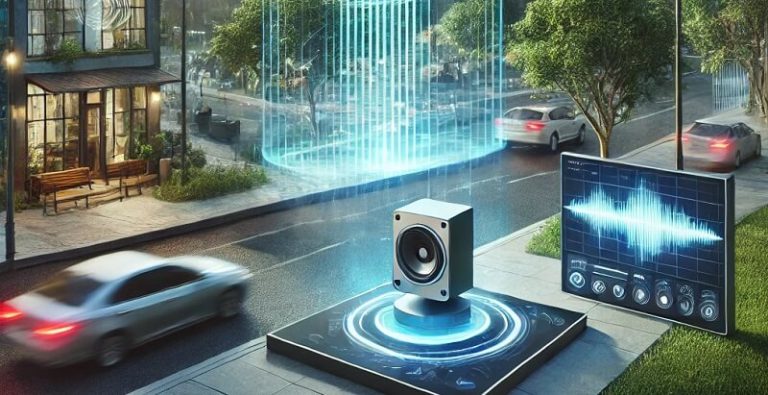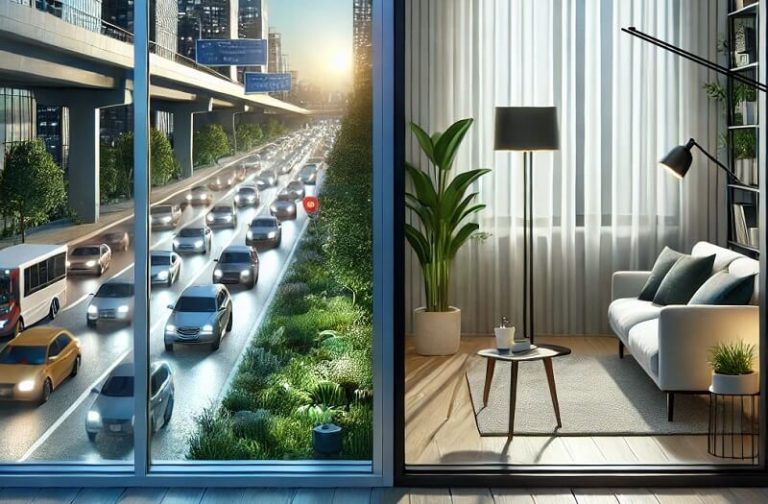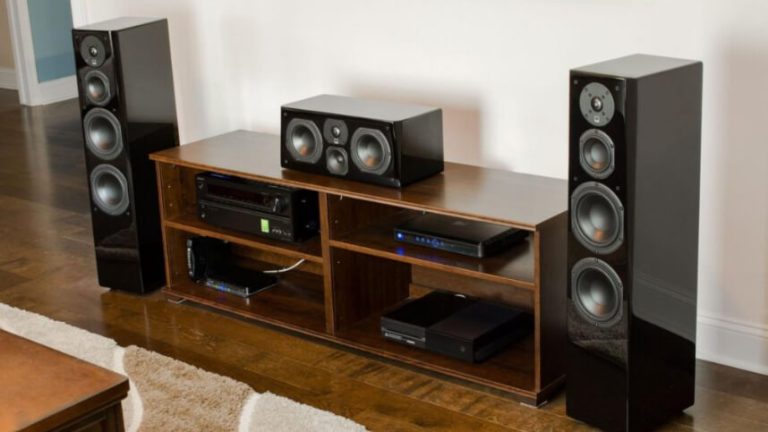
The relentless cacophony of urban life has become an increasingly pervasive issue, impacting not only our health and well-being but also the very fabric of our cities. Noise pollution, an often-invisible threat, disrupts sleep, elevates stress levels, and diminishes productivity. The World Health Organization (WHO) estimates that at least 1 million healthy life years are lost annually in Western European countries alone due to environmental noise, primarily from traffic.
Implementing effective urban noise mitigation strategies in city planning is no longer a luxury but a necessity for building sustainable and livable urban environments. This article explores the multifaceted challenges of urban noise pollution and delves into the key strategies that urban planners can employ to create quieter, healthier cities.
The Growing Challenge of Urban Noise Pollution
The relentless hum of traffic, the clang of construction, and the drone of industrial activity – these are the sounds of urban noise pollution, a pervasive issue plaguing cities worldwide. The WHO identifies prolonged exposure to high noise levels as a significant public health concern, linked to a range of adverse effects including stress, sleep disturbance, cardiovascular diseases, and cognitive impairment in children.
(WHO, Burden of disease from environmental noise, 2011). Furthermore, studies have revealed the detrimental impact of noise pollution on wildlife, disrupting communication patterns, foraging behavior, and breeding success, ultimately threatening biodiversity and ecosystem health. For example, research published in the journal “Trends in Ecology & Evolution” highlights the negative impact of traffic noise on bird populations in urban environments.
This escalating crisis demands immediate attention and innovative solutions from urban planners and policymakers to mitigate the impact of noise and prioritize community well-being.
Key Principles in Urban Noise Mitigation
Effective urban noise mitigation strategies in city planning hinge on a comprehensive understanding of how sound interacts with the built environment. These fundamental principles guide the development and implementation of noise control measures:
- Sound Absorption: This involves integrating materials and landscapes that effectively absorb sound waves, thereby reducing the overall ambient noise levels. Porous materials like open-cell foam, mineral wool, and certain fabrics are excellent sound absorbers, as are natural elements like vegetation and soil.
The effectiveness of a material’s sound absorption is measured by its Noise Reduction Coefficient (NRC), a value between 0 and 1, with higher values indicating greater absorption.
- Reflection Management: Minimizing hard, reflective surfaces like concrete and glass is crucial, as these surfaces amplify and propagate sound waves, contributing to a noisier environment. Strategic placement of sound-absorbing materials on reflective surfaces can help mitigate this effect. Employing irregular building facades and incorporating landscaping can diffuse sound reflections, reducing their intensity.
- Barrier Creation: Strategically placed natural and artificial barriers can effectively block the transmission of noise, safeguarding residential areas and creating designated quiet zones.
These barriers can range from dense vegetation and earth berms to purpose-built noise walls. The effectiveness of a barrier depends on its height, mass, and location relative to the noise source and the area to be protected.
By understanding and applying these principles, urban planners can develop targeted and impactful noise control strategies.
Strategies to Reduce Urban Noise
Zoning and Land Use Policies
Strategic zoning and land use planning are fundamental tools in the arsenal of urban noise mitigation:
- Industrial and Residential Separation: Creating buffer zones between industrial areas and residential or educational zones minimizes exposure to high noise levels generated by manufacturing and other industrial activities. This separation can be achieved through designated land use categories and strict enforcement of noise regulations.
- Mixed-Use Development: While seemingly counterintuitive, carefully planned mixed-use developments can actually reduce noise pollution by distributing noise sources more evenly and reducing the need for extensive commuting.
By integrating residential, commercial, and recreational spaces within a single neighborhood, the concentration of high-noise areas is minimized.
- Noise-Sensitive Zones: Prioritizing the location of hospitals, schools, and libraries in designated low-noise zones ensures optimal functionality and comfort for occupants. These zones can be established through zoning regulations and protected through noise ordinances.
Green Infrastructure
Green infrastructure plays a vital role in mitigating urban noise pollution through natural sound absorption and visual buffering:
- Parks and Vegetation: Trees, shrubs, and groundcover act as natural sound absorbers, reducing ambient noise levels and providing a calming effect. Studies have shown that strategically planted vegetation can reduce noise levels by 5-10 decibels.
- Green Walls and Roofs: Vertical gardens and rooftop greenery create barriers that deflect and absorb sound, providing additional insulation against noise pollution.
Green walls can be particularly effective in dense urban environments where space is limited.
- Urban Forests: Expanding tree coverage in cities not only mitigates noise but also provides a range of other benefits, including improved air quality, reduced urban heat island effect, and enhanced aesthetic appeal.
Sound Barriers and Acoustic Buffers
Physical barriers offer a direct and effective means of reducing noise transmission:
- Noise Walls: Strategically placed noise walls constructed from concrete, wood, or other sound-absorbing materials can significantly reduce noise levels in areas adjacent to highways, railroads, and industrial sites. The height and design of the wall are crucial for maximizing its effectiveness.
- Vegetated Berms: Landscaped earth mounds, or berms, provide an eco-friendly and visually appealing alternative to traditional noise walls. The combination of earth and vegetation provides excellent sound absorption and a natural aesthetic.
- Building Facades: Incorporating soundproof materials into building facades can significantly reduce noise intrusion into indoor spaces.
This can include double or triple-glazed windows, insulated walls, and specialized acoustic panels.
Traffic Management
Addressing vehicular noise is paramount for creating quieter urban environments:
- Public Transit Incentives: Encouraging the use of public transportation through improved services, subsidized fares, and integrated transportation networks can significantly reduce traffic volume and associated noise pollution.
- Dedicated Cycling Lanes: Promoting cycling through the creation of safe and dedicated cycling infrastructure not only reduces vehicular noise but also contributes to a healthier and more sustainable urban environment.
- Quieter Pavements: Utilizing porous asphalt, rubberized asphalt, and other noise-reducing pavement materials can minimize tire noise, contributing to a significant reduction in overall traffic noise levels. Studies have shown that these pavements can reduce noise by up to 10 decibels compared to conventional asphalt.
Building Design Standards
Architectural innovations and building design standards play a crucial role in minimizing urban noise within buildings:
- Soundproof Windows: Double or triple-glazed windows with laminated glass and air gaps significantly reduce noise intrusion into indoor spaces, creating a quieter and more comfortable living environment.
- Insulated Walls: Utilizing modern construction materials with high sound transmission class (STC) ratings ensures effective sound insulation between indoor and outdoor spaces, minimizing noise penetration.
- Retrofitting Older Buildings: Upgrading outdated buildings with soundproofing materials and techniques can bring them up to contemporary noise reduction standards, improving the quality of life for occupants.
Quiet Zones
Designating specific areas as quiet zones helps preserve tranquility and protect noise-sensitive areas:
- Residential Quiet Hours: Enforcing noise limits during specific hours, particularly during nighttime hours, promotes restful sleep and enhances the quality of life in residential areas.
- Protected Public Spaces: Designating parks, libraries, and other public spaces as quiet zones provides refuge from the constant noise of urban life, offering spaces for relaxation and contemplation.
- Signage and Awareness: Clear and prominent signage in quiet zones reinforces noise regulations and promotes public awareness of the importance of maintaining tranquility in these areas.
Smart Technology and Data-Driven Planning
Technological advancements are revolutionizing urban noise management:
- IoT Noise Sensors: Deploying a network of interconnected noise sensors throughout the city allows for real-time monitoring of noise levels, enabling the identification of noise hotspots and facilitating targeted interventions.
- Data Analytics: Analyzing data collected from noise sensors provides valuable insights into noise patterns and trends, informing better planning decisions and enabling the development of more effective noise mitigation strategies. This data can be used to create noise maps, identify problem areas, and evaluate the effectiveness of interventions.
- AI-Powered Tools: Artificial intelligence (AI) is being utilized to optimize traffic flow, manage traffic signal timing, and even design urban layouts to minimize noise pollution and improve overall urban soundscapes.
Case Studies: Cities Leading the Way in Noise Mitigation
Singapore
Singapore has emerged as a global leader in urban noise mitigation through a combination of innovative strategies.
The nation’s Land Transport Authority has implemented an extensive noise monitoring network, enabling real-time noise level tracking and targeted interventions. Strict regulations on construction noise and traffic management, combined with extensive green infrastructure development, contribute to a surprisingly serene urban environment despite its high population density. Initiatives like the “Lush Acoustics” program encourage the use of specific plant species for enhanced noise absorption in urban spaces.
Copenhagen
Copenhagen’s commitment to sustainable transportation has resulted in a significantly quieter urban soundscape.
The city’s extensive network of dedicated cycling lanes and its prioritization of pedestrian-friendly streets have dramatically reduced traffic noise. Furthermore, the city actively promotes the use of electric vehicles and public transportation, further contributing to lower noise levels. The city’s “Quiet Streets” initiative identifies and addresses specific noise hotspots through targeted interventions like traffic calming measures and noise barriers.
This has led to a measurable reduction in noise levels and an improvement in the quality of life for residents.
New York City
New York City, despite its reputation for its vibrant and sometimes noisy environment, has implemented proactive measures to address noise pollution. The city’s 311 system enables residents to report noise complaints, facilitating timely responses from relevant authorities. Noise mapping and monitoring programs provide valuable data to inform policy and enforcement efforts.
Furthermore, the city’s PlaNYC initiative includes provisions for noise reduction through green infrastructure development, traffic management, and building code revisions.
FAQ
What is the most common source of urban noise pollution?
Traffic noise, including the sounds of vehicle engines, horns, and tire friction on pavement, is the most prevalent source of noise pollution in urban areas worldwide.
How do green spaces help reduce noise?
Green spaces, including parks, trees, and green walls, absorb and diffract sound waves, effectively reducing noise propagation. The leaves, branches, and groundcover create a natural sound buffer, dampening noise levels and creating a more tranquil environment. They also offer psychological benefits by providing a sense of calm and reducing stress associated with noise exposure.
Can smart technology help reduce noise pollution?
Yes, smart technologies like IoT noise sensors, data analytics platforms, and AI-powered traffic management systems are proving invaluable in addressing noise pollution.
These tools enable real-time noise monitoring, identification of noise hotspots, optimization of traffic flow, and informed urban planning decisions, leading to more effective noise mitigation strategies.
Conclusion
Mitigating urban noise is not merely about reducing decibel levels; it’s about enhancing the health, well-being, and overall quality of life for urban residents. By integrating comprehensive urban noise mitigation strategies in city planning, encompassing zoning policies, green infrastructure, sound barriers, advanced technologies, and community engagement, we can transform noisy urban landscapes into vibrant yet peaceful environments. This requires a collaborative effort from urban planners, policymakers, researchers, and citizens alike.
Let’s embrace innovative solutions and advocate for policies that prioritize quiet and healthy urban spaces for present and future generations.






